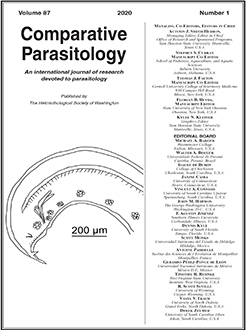Natural infections of Paulisentis missouriensis (Acanthocephala), Rhabdochona canadensis (Nematoda), and Allocreadium lobatum (Trematoda) in the intestine of creek chub (Semotilus atromaculatus) were studied to determine whether microhabitat use of these helminths was affected by interspecific interactions. Comparison of mean relative positions and intestinal segment use of all 3 helminths revealed no negative interactions among the 3 species. Paulisentis missouriensis appeared entirely unaffected by the presence of either R. canadensis or A. lobatum. Each of the latter 2 species, however, appeared to exhibit some shift toward, rather than away from, the location of P. missouriensis in co-infected hosts. However, the effect size in both cases was small and therefore could be spurious. At higher intensities of co-infecting P. missouriensis, worms of A. lobatum were either distributed far to the anterior or far to the posterior of the intestinal locations occupied by P. missouriensis. This constituted the only evidence in the present investigation for negative interspecific interactions among these 3 frequently co-occurring helminths in this system.
How to translate text using browser tools
12 May 2020
Effects of Interspecific Interactions on Microhabitat Use of Three Helminths Parasitizing Creek Chub (Semotilus atromaculatus) in Southeastern Nebraska
Michael A. Barger
ACCESS THE FULL ARTICLE

Comparative Parasitology
Vol. 87 • No. 1
January 2020
Vol. 87 • No. 1
January 2020
Acanthocephala
Allocreadium lobatum
competition
interspecific interactions
microhabitat specificity
Nebraska
Nematoda




